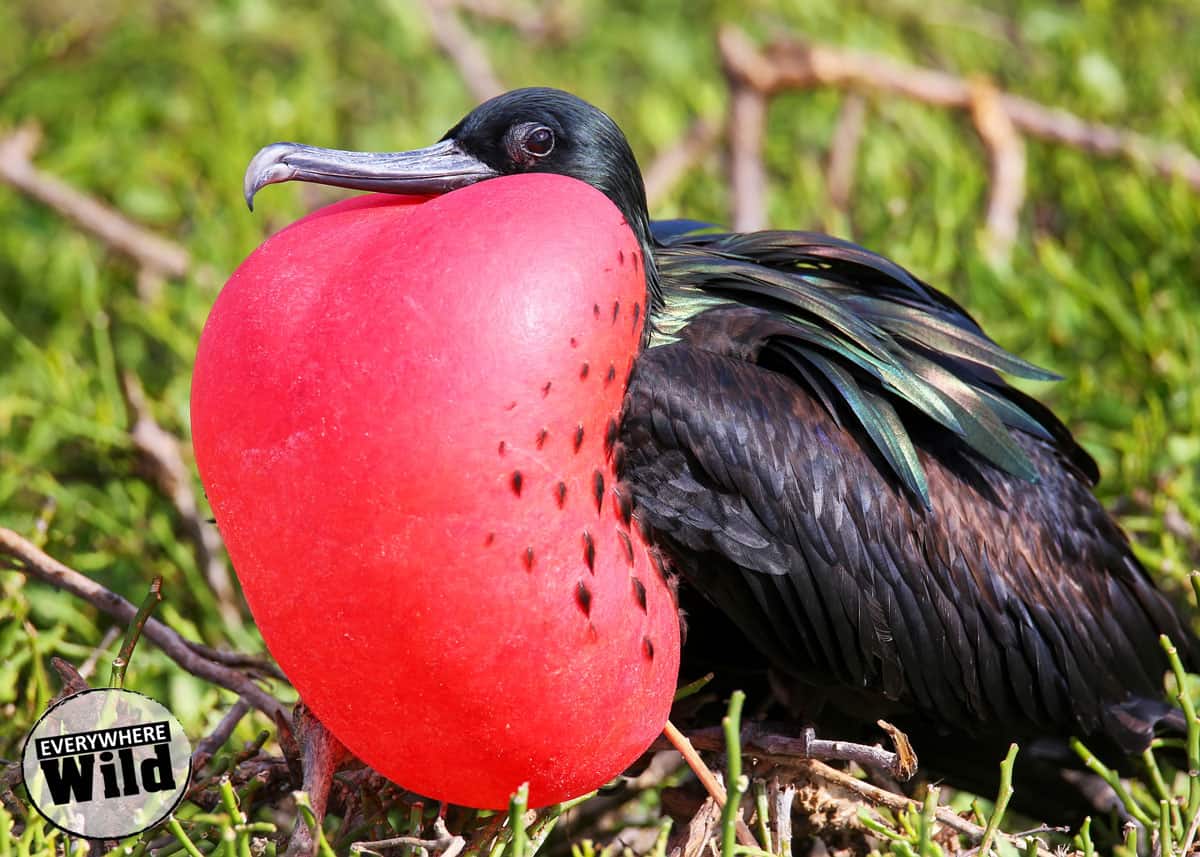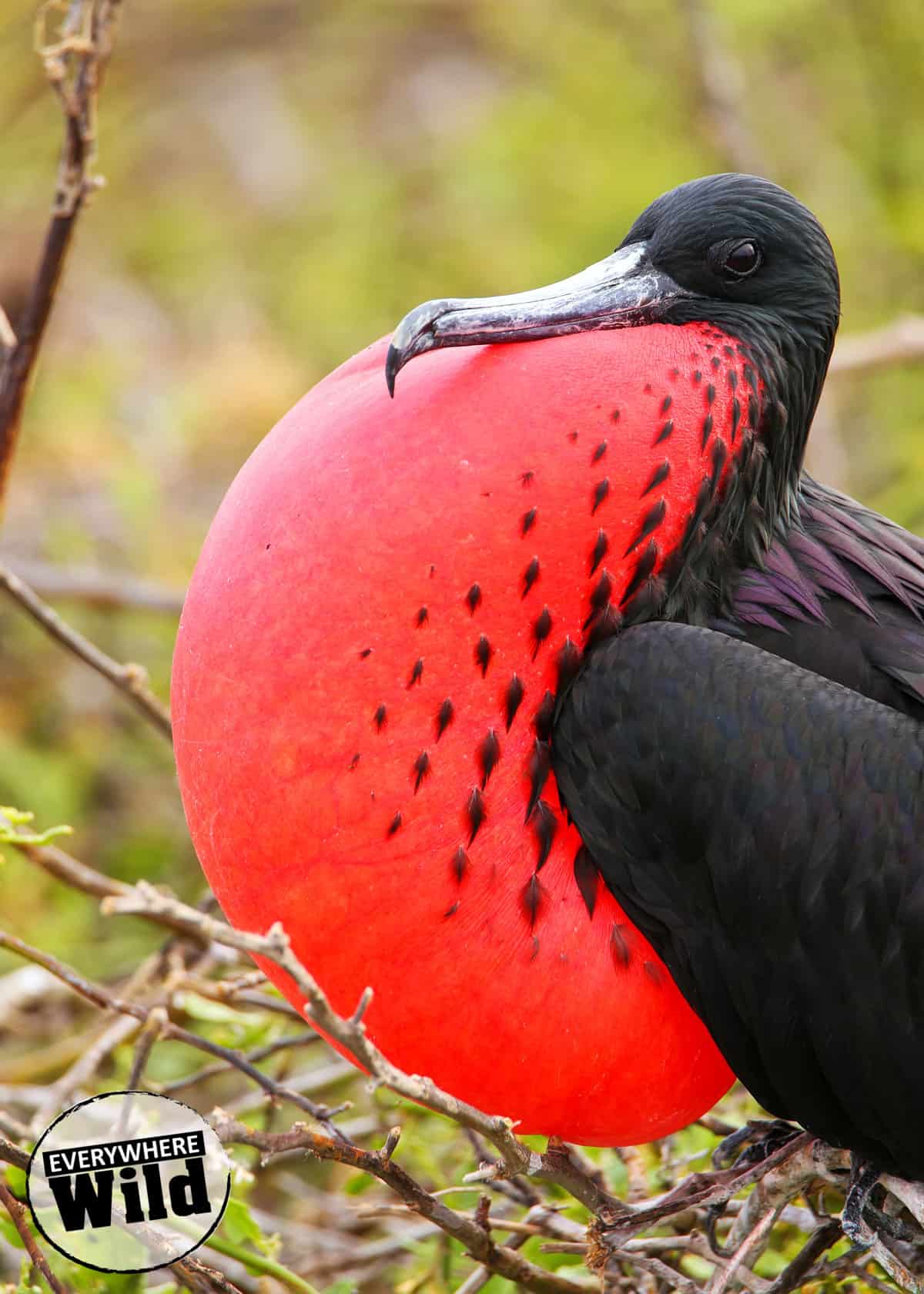Have you ever wondered how to tell these birds apart? Great frigatebird vs magnificent frigatebird – what’s the difference?

Frigatebirds (both great and magnificent) are seriously cool birds. In this post, you’ll learn how to tell great and magnificent frigatebirds apart and some awesome frigatebird facts.
14 Frigatebird Facts: Here are 8 differences between these two frigatebirds plus 6 facts that apply to both birds.
Table of Contents
Great Frigatebird vs Magnificent Frigatebird: 8 Differences
These are the 8 main differences between great frigatebirds (Fregata minor) and magnificent frigatebirds (Fregata magnificens).
1. The Sheen
The male great frigate has a green sheen, or shine, on its black back feathers whereas the male magnificent frigate prefers a purple sheen.
The sheen makes for an awesome fashion statement and makes it much easier to tell the two birds apart. While both colors are quite visible, the green can be brighter than the purple and thus easier to spot.

Notice the purple sheen on the back of this Magnificent frigatebird
2. Eye Rings
The female great frigate has a red eye ring and the female magnificent frigate sports a blue eye ring.
All da ladies love da eyeliner, no?

Female great frigatebird with the red eye-ring
3. Size
The magnificent frigatebird is larger than the great frigatebird by roughly 2-4 in (4-9 cm) in length, 4-5 in (12-14 cm) in wingspan, and .23-.51 lb (100-140 g) in weight. In both species, the female is slightly larger than the male.
For all you number people, knock yourselves out:
- The magnificent frigatebird is 35-45 in (89-114 cm) long with a wingspan of 85-96 in (217-244 cm), and weighs 2.43-3.51 lb (1,100-1,590 g).
- And the great frigatebird is 33-41 in (85-105 cm) long, with a wingspan of 81-91 in (205-230 cm), and weighs 2.20-3.20 lb (1,000-1,450 g).
4. Spanish Name
The great frigate (was once called “man of war”) is referred to as Pajaro Pirata, or “pirate bird” because of kleptoparasitism, wich I’ll talk about further down.
The magnificent frigate is referred to as Rabihorcado, or “forked tail,” because of the birds long, scissorlike tail (present in both species of frigatebird).
5. Diet
The great frigate feeds mostly on flying fish, squid, and other fish relatively far from shore, whereas the magnificent frigate feeds closer to shore.
By having these distinct hunting grounds, the frigates avoid competition with one another. As I mentioned above (and will discuss in more detail further on) both birds are kleptoparasitic.
6. Sound/Call
The magnificent frigate makes a drumming or rattling noise while the great frigate makes a gobbling noise like a turkey.
7. Coloring of the Young
Great frigatebird young have dark brown-black wings with a white underbelly and head. The head will also have rust colored patches until the chick matures.
Magnificent frigatebird young have a white head, neck, and breast. The look very similar to the great frigates but lack the rust-colored patches.
8. Distribution
The magnificent frigate breeds and lives from Mexico to Ecuador (including the Galapagos Islands off the coast of Ecuador), as well as in Florida and the Caribbean. Scattered colonies have been found in BC, Spain, Denmark, England, and the Isle of Man.
The great frigate breeds and lives from Wake Island to the Galapagos to New Caledonia, some in Australia, and about 10,000 pairs in Hawaii. There are also a few colonies in the Indian Ocean, such as Mauritius, Maldives, Christmas Island, and Aldabra.
Don’t Stop Just Yet!!
Those are my 8 differences between the great frigatebird and the magnificent frigatebird. But don’t stop here!
Read on to see some awesome frigatebird facts that these cool birds have in common.
6 Awesome Frigatebirds Facts
This includes facts about both the magnificent frigatebird and the great frigatebird.
1. To Sea or Not to Sea
While both frigatebirds feed on many different types of fish, they cannot land on the water because they are not waterproof.
If they were to land on water they would not be able to take off again. I find it amusing that a seabird cannot alight on the sea.
2. Klepto-what?
Even though it only makes up about 5% of their diet, frigatebirds will often indulge in kleptoparasitism.
Big, ugly, word, but “kleptoparasitism” means thief or theft. For great and magnificent frigatebirds, this involves stealing as much as possible from as many other birds as possible.
The frigates will catch other birds in mid-air by their tailfeathers and violently shake them until they disgorge whatever food they may be carrying. The frigatebird will then catch the food (most likely fish) before it hits the water.
If you travel to the Galapagos, you will most likely see a frigatebird with a barfing blue-footed booby in its clutches.
3. Now Don’t be Coy…
The red balloon on the male frigatebird’s neck is called a “gular sac.”
During the breeding season (depending on the area it could be year round, but is typically March and April in the Galapagos) the male will force air into his gular sac and inflate it over a period of around 20 minutes.
4. Black Like the Night
Male and female frigatebirds are all black except for their chest, with the male haveing his famous red gular sac and the female having a white patch, wich may extend up her neck.
5. “Hooked” on Success
The frigates have a thin, hooked beak which makes their fishing much easier.
Their strange-looking bill facilitates their fishing and kleptoparasitism.
6. Warship
Did you know…? The frigatebird is named after the old warships from the 17th-19th centuries.
The frigates were fast ships that were easily maneuverable – very similar to their aviary counterparts. Frigatebirds are also referred to as “Man of War” as I mentioned above.
These strong, violent, and majestic names truly describe the birds. Their quick, graceful flight, their dark black color, and their naughty kleptoparasitic behavior have earned them their name.

That’s All, Folks!
I hope you enjoyed my comparison of great frigatebirds vs magnificent frigatebirds and my frigatebird facts.
I loved seeing these animals first hand when we traveled to the Galapagos; I wish I had researched them before we went to Galapagos! In my opinion, knowing as much as possible about an animal definitely enriches the experience of seeing them first hand.
Do you have any frigatebird facts to add (about either frigate)? Please share them in the comments; I’d love to hear from you!
Drew Haines is an animal enthusiast and travel writer. She loves to share her passion through her writing.
She graduated high school at sixteen and started her own business, Everywhere Wild Media. And she runs Everywhere Wild and JustBirding. She also guest blogs on Storyteller.Travel
She lived in Ecuador for 6 years and explored the Galapagos Islands. Currently based in N.S., Canada.

Amy
Tuesday 14th of July 2020
Since Covid, I've been seeing huge, dark colored sea (?) birds cruising above Honolulu about a mile or three inland, sometimes in groups. I guess they are Great Frigatebirds. Their wingspans seem to be over six feet, they are high up and gliding. Wonder why. We do have feral chickens.
Wolfgang
Tuesday 19th of May 2020
Many thanks for the wonderful comparison of the two species. Very well presented.
30 Magnificent Frigatebird Facts: Balloon-Throated Aerial Pirates (Fregata magnificens) | JustBirding.com
Tuesday 26th of March 2019
[…] are two visible differences between these […]
Pam Topor
Sunday 17th of March 2019
Really enjoyed reading this. I have just started birding and believe I saw a magnificent frigate bird while in Puerto Rico. Appreciate the info very much.
Drew Haines
Monday 25th of March 2019
Thanks so much, I'm glad you enjoyed it! Since you've started birding I think you might really enjoy our sister site, JustBirding.com. I blog about tons of amazing birds and birding tips over there :).
17 of the Weirdest Birds in the World (Photos, Facts, Videos...) | JustBirding.com
Tuesday 1st of January 2019
[…] look at the magnificent frigatebird, and you probably won’t ever forget […]